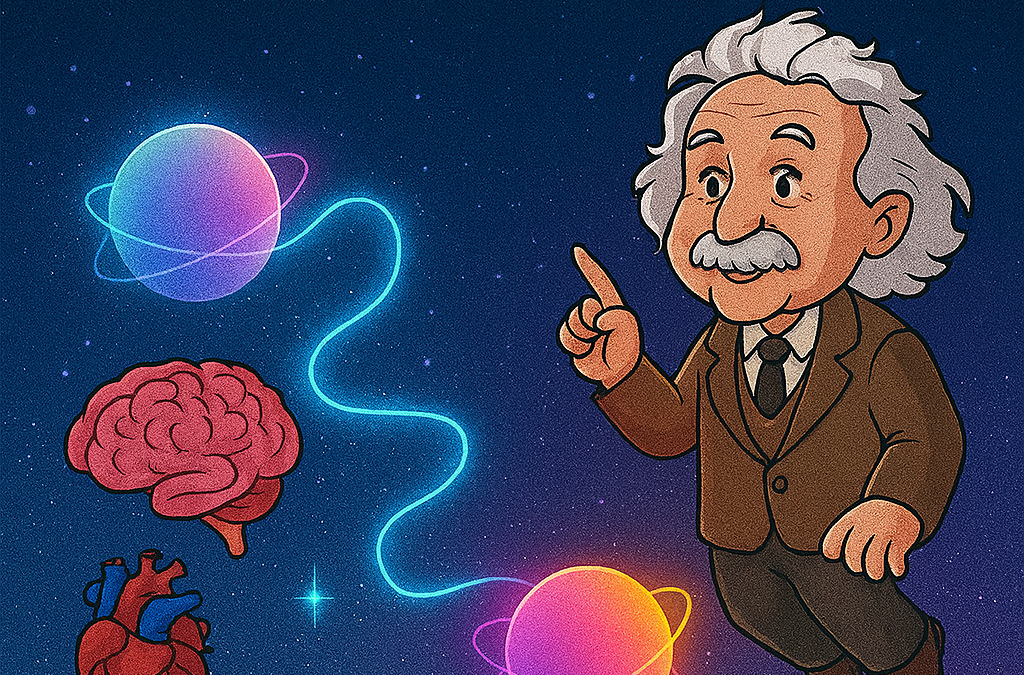Let’s start at the beginning with an understanding of what Quantum entanglement means and where it came from.
Quantum entanglement was first described in the 1930s by physicists Albert Einstein, Boris Podolsky, and Nathan Rosen, and later named by Erwin Schrödinger. It was experimentally confirmed decades later by physicists like John Clauser and Alain Aspect.
Quantum entanglement is where two or more things as in particles are so deeply connected that when one changes, the other reacts instantly—even if they’re far apart. Albert Einstein called this, “spooky action at a distance”.

- Quantum entanglement usually involves subatomic particles like electrons, photons, or qubits.
- These particles become linked in a way that their states affect each other instantly, even across distance.
- Atoms are made of particles (protons, neutrons, electrons), so entanglement can happen between atoms if their internal particles are entangled—but it’s the particles themselves that do the entangling.
In the human body, this can show up as your brain, heart, and gut working together—like when your stomach tightens before your brain knows you’re anxious, or your emotions shift your thoughts in a flash. For neurodivergent people, especially those with ADHD and ASD1 – Autism level 1 (Asperger’s) traits, these systems are more sensitive and tightly linked—so everything feels faster, louder, and more connected. It’s like your body is wired to pick up signals from all directions at once in a non-linear fashion.
If you live with ADHD and ASD1 traits, your body might feel like it’s doing everything at once. You might think fast, feel deeply, and react quickly. You might also freeze, shut down, or feel stuck. This guide helps you understand what’s happening inside—and how to gently steer your system with clarity and care.
🌟 Step 1: Meet Your Body’s Three Main Systems
Your body has three key systems that help you think, feel, and respond:
| System | What It Does | GABA (Calm) | Glutamate (Energy) |
| 🧠 Brain | Thinks, plans, solves problems | Slows racing thoughts | Sparks ideas and focus |
| ❤️ Heart | Feels emotions, connects with others | Soothes big feelings | Fuels passion and empathy |
| 🌿 Gut | Reacts to stress, keeps you safe | Calms tension | Activates alertness and instinct |
So essentially, the brain transmitter, GABA, acts as a break and sows things down where as, Glutamate starts and energises. Meaning that these neurotransmitters act as stop and go mechanisms.
When you have ADHD and Asperger’s traits, these systems can be extra sensitive. You might have too much glutamate (energy) and not enough GABA (calm). That can lead to:
- Fast thoughts and trouble focusing
- Strong emotions and sensory overload
- Body tension or shutdown when things feel too much
🌀 Step 2: Understand Your Quantum Wiring
Your body works like a quantum field—it can hold many states at once. This is called superposition in physics.
This can look like:
- Logical & Creative.
- Craving routine & structure & novelty.
- Seeking social interaction & limiting time to recharge body battery.
This is normal for neurodivergent people. You’re not broken—you are multidimensional.
🔗 Step 3: Notice the Connections
Your brain, heart, and gut are deeply connected. This is like quantum entanglement—when one part is activated, the others respond. You might notice:
- Your gut reacts before your brain understands – intuition, a knowing.
- Your heart feels something before you can explain it.
- Your brain races while your body freezes.
This is why regulation needs to include your whole body, not just your thoughts.
🚀 Step 4: Use Your Inner Dashboard
Imagine your body like a dashboard with signals coming from your brain, heart, and gut:
- Glutamate is your energy switch—it gives you speed, ideas, and alertness.
- GABA is your calming switch—it helps you slow down, rest, and choose where to go.
- Your body systems send signals to help you steer.
When things feel messy or overwhelming stop and take a moment to centre yourself and balance your breathing out by breathing in through the nose for 3 seconds and out through the nose for 3 seconds and then ask:
- “Which part of me needs help right now?”
- “Do I need to calm my thoughts, my feelings, or my body?”
- “What helps me land gently?”
Allow the first thing that comes in to be the answer because you’re working with your subconscious and run with it.
🌈 Step 5: Choose Your Landing Tools:
| System | When It Feels Overwhelmed… | Try This |
| 🧠 Brain | Racing thoughts, scattered focus | Ask a clear question |
| ❤️ Heart | Big emotions, shutdown, sensitivity | Hand on heart, gentle music, connection |
| 🌿 Gut | Tension, nausea, panic, freeze | Slow breathing, warm drink, grounding touch |
You don’t have to fix everything. You just need to choose where to land, ground and balance yourself through self-soothing techniques to regulate your nervous system like the one’s suggested or what ever works for you.
💫 Final Reminder
You are not one thing. You are many things at once—that’s your power and what it means to be quantum.
Navigating ADHD and ASD1 traits with quantum awareness means honouring your complexity, listening to your body, and using tools that help you land with clarity, confidence, and certainty through your everyday life.
You can download this for FREE in a PDF https://amandabowden.co.uk/wp-content/uploads/2025/11/Navigating-your-ASD1-ADHD-Quantum-Body.pdf
If you want to find out more about how I can help you as a coach, simply book yourself in for a FREE discovery call on the link https://tidycal.com/amandabowden222/20min20231226112538
Or get in touch via email amandabowden222@gmail.com
Or WhatsApp/phone: 07921845961
Amanda Bowden – Transitional Coach 2025 ©️

